Product
The product that is being studied is a chronograph, which is timepiece that is supposed to give accurate time. A chronograph is a watch with time keeping, stopwatch, and other functions. These products are priced very high (usually above $5000) and their STP strategy is decided accordingly.
The main aim of the advertisement campaigns of all the five brands is to demonstrate the uniqueness and the design of the product. The advertisements usually demonstrate the product very clearly and the message is always related to the product. The product is demonstrated through its technical precision, its designing, and the exclusivity of the product.
For instance, Breitling advertisements demonstrate it to be the product for the aviation industry in order to demonstrate its durability in high-pressure conditions as in while flying a plane. Further, it also demonstrates that the product is of high technology and mechanical value and has a design that suits the high-tech minds.
Rolex on the other hand flaunts style and luxury. A Rolex watch is advertised as a symbol of classiness. For instance, the timeless value attached with Rolex watches are expressed in advertisements featuring 76-year-old model Carmen Dell’ Orefice and tagline “Class is forever”.
Hublot in its latest campaign shows off the product as expensive, technical gadget that is an envy of all. Therefore, the Hublot ad by Ecclestone states, “See what people will do for a Hublot,” indicating the high quality and desirability of the product.
Tag Heuer’s product is a chronometer, which is sold more for its fashion value than its engineering. Therefore, the advertisements are mostly celebrity endorsed indicating a lifestyle rather than the product and with taglines like “What are you made of”. The product represents style, panache, and success rather than technicality like Breitling or Audemars Piguet.
Segmentation
Traditionally all five of the luxury watches chose an income segment of very rich individuals. The segment for luxury watches has been of three types – the exclusive luxury segment, the affordable luxury segment, and the mid and low range luxury segment depending on the prices the products are offered at. (See figure 1)
The advertisements made by the brands demonstrate this quality of it being expensive. For instance, Rolex’s advertisements demarking a high-rise corporate office and stating, “If you were speaking here tomorrow you would wear a Rolex” implying that if one were rich enough tomorrow one would want to wear a Rolex watch.
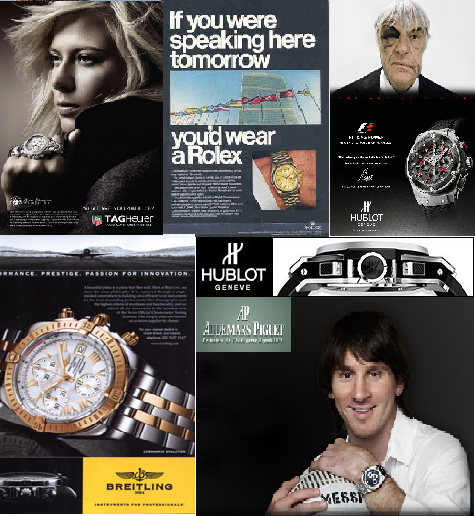
Similarly, Breitling maintaining its segment of the rich caters to all in aviation and for those who like to fly. Tag Heuer’s 2009 “The Knights of Time” campaign with tagline “What are you made of?” shows and speaks of people who succeeded in life through hard work.
Hublot’s 2010 advertisement featuring F1 supreme Bernie Ecclestone’s untouched battered profile after he was mugged for an expensive Hublot watch with the tag “See what people do for Hublot”. Audemars Piguet started a campaign of painting its brand name in New York’s 34th Street Heliport to capture the eye of the business execs flying in choppers, clearly aiming at a very wealthy market segment .
Target
All these brands have distinct target groups. Therefore, usually the advertisements for all the five brands are placed accordingly to reach the targeted demographics i.e, wealthy men. For instance, Breitling targets professionals. They use the tagline “Instruments for Professionals” and they target men with high income, eager to purchase a chronometer.
Breitling does most of its advertisements in magazines like GQ, Time, and TV ads. Rather they target all professionals, be it in sports, fashion, acting, or business. The demographic age targeted by Breitling is above 20, and mostly towards high-income men.
Rolex puts in its print advertisements in high-end lifestyle magazines like Monocle. Rolex uses multiple celebrity endorsement for their ad campaigns in order to represent strong and successful professionals. The target is made clear through the advertisements – hard working professional achievers.
Rolex uses endorsers (see figure 2) like tennis player Roger Federer with tags “Let’s not talk history yet. He’s still making it” and No. 1 women’s golfer Lorena Ochoa with the tag “Rolex. A crown for every achievement” . Rolex targets both men and women above 20 years. For instance ads endorsed by Lorena Ochao or Ana Ivanovic.
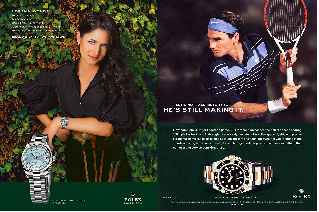
On the other hand, the target customers for Hublot and Tag Heuer are sporty professionals looking for adventure. While that of Audemars Piguet are executives and rich professionals who would want more conventional style but equally technically sound instruments.
Hublot, Tag Heuer, and Audemars Piguet targets both men and women. Hublot targets women through ladies sports celeb endorsement. Tag Heuer advertises with female endorsers like tennis player Sharapova or actor Uma Thurman. Audemars Piguet has targeted women though a little unconventional advertisements with taglines “Fiery Beauty” .

A new way of reaching the rich professionals is through online and mobile ads. Advertising through new media especially through apps in Smartphone instantly allows the brand to reach a group of target customers who are wealthy and tech-savvy as these chronometers are high-end critically engineered products. Breitling, Rolex, Audemars Piguet has started mobile marketing for its watches through Smartphone apps.
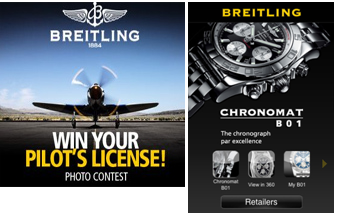
Rolex has started using new media as their advertising medium. It has advertised in Life.com with a ticking Rolex watch and has partnered with Golf Digest to make mobile apps and have made their own Rolex apps . In all these advertisements the targets are same wealthy professionals who usually use smart phones and are compatible with iOS or Android.
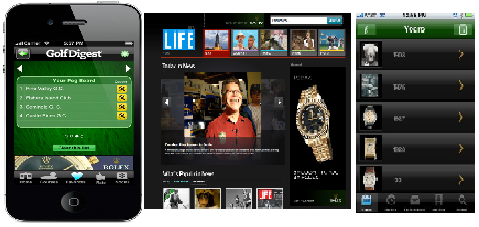
Hublot too in line of Breitling has made free iPhone apps and Audemars Piguet has launched its latest apps for iPhone4.
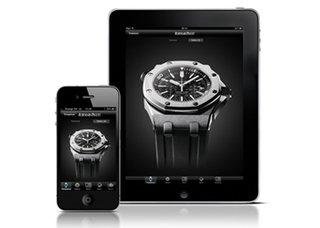
Positioning
The positioning of these brands is distinct and is expressed through their advertisements very clearly. Breitling positions itself on classical engineering and instrumentation technology of chronometers . Rolex is positioned more as a luxury watch with moderate technicality and high on exclusivity and design .
Therefore, they use such tags as “Class is forever” or associate it with success. Hublot on the other hand positions itself on engineering, design, and exclusivity of the product (e.g. Ecclestone ad) . Tag Heuer positions itself as a sporty fashion brand shown through its sports and fashion endorsements like that of Brad Pitts, Uma Thurman, Leonardo de Caprio, Maria Sharapova, etc. Audemars Piguet is a brand that has its positioning very high on technical and mechanical complexity and exclusivity.
References
Audemars Piguet, 2011. Audemars Piguet launches a new feminine advertising campaign. Web.
Breitling Official Channel, 2010. Breitling Official Channel. Web.
Breitling, 2010. iTunes Preview. Web.
Hublot, 2011. Brand Communication. Web.
Hutzler, K., 2011. Rolex, Golf Digest tap mobile apps for 100 Greatest Golf Courses franchise. Web.
Lamb, R., 2011. Breitling takes to the skies with Facebook promo. Web.
Rodgers, Z., 2009. Thing of Beauty: Ticking Rolex Ad on New Life.com. Web.
Rolex, 2011. About Rolex. Web.
Tag Huer, 2011. Tag Huer. Web.
Zelesny, E., 2011. What’s up with the pricey Rolex app? Web.